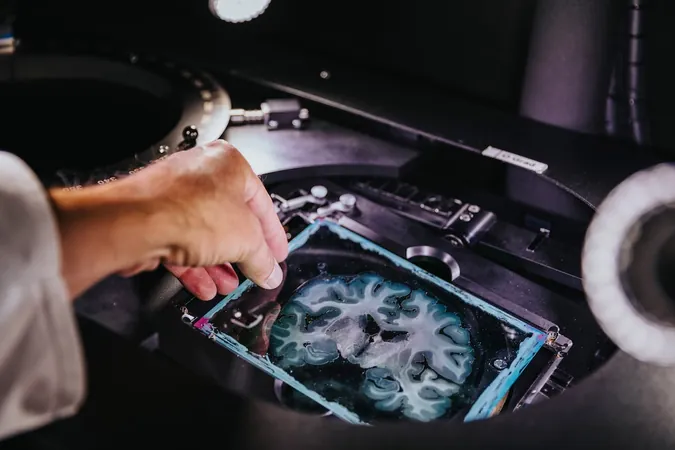
Unveiling the Hidden Secrets of Memory: It's Not Just the Brain!
2025-01-03
Author: Wei
Introduction
Memory is a quintessential aspect of what defines humanity. While it’s widely recognized that many animals can learn and recall experiences, there's a long-held belief that their memories lack the emotional depth we associate with human recollections, like the evocative imagery from Marcel Proust's famed madeleine. Recent research, however, is flipping this idea on its head, revealing that the mechanisms of memory may extend far beyond the confines of neural networks.
Memory in Non-Neural Cells
Scientists are discovering that memory functions similarly in non-neural cells, potentially unlocking new pathways for understanding cognitive decline and offering innovative solutions for enhancing memory. Imagine a kidney cell that, while it may not reminisce about “Hotel California” by The Eagles, can “learn” in a way that provides valuable insights into our own memory processes.
Historical Perspectives on Memory
The exploration of memory isn’t a modern innovation. Philosophers like Plato and Aristotle have likened memory to engravings on wax, but it wasn't until the 19th century that structured studies began to unveil its complexities. German psychologist Hermann Ebbinghaus pioneered experimental methods to study memory, and Richard Semon later introduced the concept of the engram - the physical substratum of memory within neurons. However, the era of modern biology in the latter half of the 20th century truly propelled our understanding of how memories are formed and retained at a molecular level.
The Spacing Effect
One fascinating phenomenon noted by Ebbinghaus in 1885 is the “spacing effect,” which indicates that we retain information more efficiently when studying is spaced out over time rather than crammed in short bursts. This insight is well-supported, as numerous studies have shown the effectiveness of spaced learning methods, both in humans and in animal models with simpler nervous systems, like sea slugs.
Groundbreaking Research
Enter the groundbreaking research led by Nikolay Kukushkin at New York University, which has now extended this concept of the spacing effect beyond neural cells. By modifying kidney cells to reveal activation of the CREB protein—a crucial player in memory processing—Kukushkin’s team demonstrated that these non-neural cells exhibit a memory-like response when exposed to spaced stimulation. Remarkably, the kidney cells generated greater light emission after receiving multiple short pulses of stimulation than they did from a single prolonged exposure, suggesting they also “learn” and remember more effectively when experiences are spaced out.
Implications for Understanding Memory
This monumental finding has furthered our understanding that learning is not unique to neurons—cells throughout our body may possess similar capabilities. Published in *Nature Communications*, this research showcases an intriguing possibility: all cells could inherently have a fundamental property of learning through experience, much like neurons do.
Cellular Memory Studies
Adding to this body of knowledge, recent studies from Harvard University and Barcelona's Center for Genomic Regulation have used computational models to illustrate how individual cells could retain memories of past stimuli, leading to learned behaviors such as habituation. Lead researcher Rosa Martínez-Corral emphasizes that these findings highlight a cellular form of memory, allowing cells to adjust their future responses based on prior experiences.
Potential Therapeutic Applications
This understanding could open new doors for treatment strategies. If non-neural cells can tolerate environmental changes or “learn” resistance—such as cancer cells adapting to chemotherapy—scientific advancements informed by these discoveries may refine therapeutic approaches.
Conclusion
In essence, the revelations about memory in non-neural cells not only challenge our understanding of cognition but also lay the groundwork for further exploration of memory's intricate mechanisms across all types of cells. As our understanding of memory deepens, we may uncover strategies to enhance both cellular responses and human learning processes, guiding us toward solutions for memory-related disorders and broader medical applications. The concept of memory, it seems, transcends the brain, and research in simpler systems could illuminate many fundamental biological questions yet to be answered.


 Brasil (PT)
Brasil (PT)
 Canada (EN)
Canada (EN)
 Chile (ES)
Chile (ES)
 Česko (CS)
Česko (CS)
 대한민국 (KO)
대한민국 (KO)
 España (ES)
España (ES)
 France (FR)
France (FR)
 Hong Kong (EN)
Hong Kong (EN)
 Italia (IT)
Italia (IT)
 日本 (JA)
日本 (JA)
 Magyarország (HU)
Magyarország (HU)
 Norge (NO)
Norge (NO)
 Polska (PL)
Polska (PL)
 Schweiz (DE)
Schweiz (DE)
 Singapore (EN)
Singapore (EN)
 Sverige (SV)
Sverige (SV)
 Suomi (FI)
Suomi (FI)
 Türkiye (TR)
Türkiye (TR)
 الإمارات العربية المتحدة (AR)
الإمارات العربية المتحدة (AR)